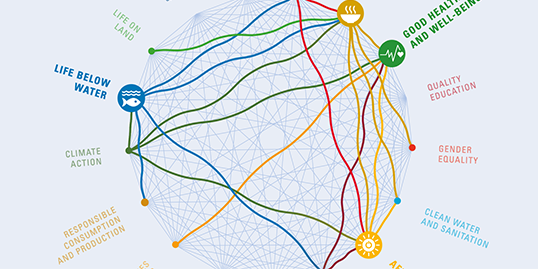Måns Nilsson argues that a new framework could give a major boost to implementation and dialogue.

The 2030 Agenda for Sustainable Development emphasizes interlinkages and interactions among its 17 Sustainable Development Goals (SDGs), and the importance of implementing them as an “indivisible whole”. As development analysts, policy-makers and practitioners are well aware, doing so will require managing both reinforcing relationships and trade-offs between targets and goals in different sectors.
This realization has often amplified calls for radical shake-ups of institutions, new intersectoral bodies, “breaking down silos”. But as my colleague Åsa Persson has argued, the answer to intersectoral challenges is not always new cross-sectoral institutional arrangements. What matters, first and foremost, is that interactions between policy areas that fall within the remit of different institutions are taken into account in framing problems and designing action – something that too often does not happen.
If we are to think more carefully about policy coordination, what exactly is it that should be coordinated? Integrating everything with everything is hardly the answer. As a basis, we first need to understand how the different policy areas interact. Second, this knowledge needs to be accessible and understandable by decision-makers tasked with devising strategies to implement the SDGs, such as officials in national ministries for planning and investment.
So, first, how do we go about identifying and assessing these interactions? Even if the same sets of targets interacted in the same way in every context, the sheer number of possible interactions is already huge. But of course they don’t, and different ways to approach the same target could completely change the character and intensity of the interactions. There is an urgent need for tools and language to help cut through this complexity.
Through my work at SEI and the International Council for Science (ICSU), I have been involved in several projects that are seeking to rise to the challenge. Last year I was asked by UNDESA to present an initial assessment of interactions between targets under the six SDGs in the spotlight at this year’s High-Level Political Forum: goals 1 (on poverty), 2 (on hunger and food security), 3 (on health), 5 (on gender) 9 (on infrastructure and industrial development) and 14 (on oceans and seas).
Happily, I had a wealth of research on several of these goals to call on, thanks to the on-going interactions study being coordinated by ICSU at the time. The results are summarized in a new SEI Working Paper, while in-depth goal-by-goal studies were published by ICSU this week.
In the Working Paper, I apply the seven-point scale of interactions that I together with colleagues David Briggs and Martin Visbeck proposed in Nature last year, to indicate the degree of reinforcement, or conflict, between pairs of targets. I also identify “directionality” in the interactions: is it progress on target A that affects progress on target B, or vice versa, or are there reciprocal links? I also note some contextual dependencies: would the interaction be the same in every case, or could it play out differently depending on local factors, or the strategies chosen. Finally, I include comments on the level of agreement and scientific knowledge about the interactions.
It could be argued that this kind of exercise is too general to inform real policy-making. Certainly this initial study, which only aims to start the conversation and thought process in the preparations for the HLPF, could only provide illustrative examples. It could also not capture the systems effects of possible interactions within a national (or other) system: they will certainly often happen in clusters larger than pairs, and they could have knock-on and ripple effects through the system. More complete and detailed mapping will depend on longer term, in-depth research work going goal by goal, at national or possibly country-group level.
But for all the importance of context, these interactions are so important and yet so poorly documented that there appears to be definite value in building up an international knowledge base. Many interactions will be similar in different countries and contexts. Pooling knowledge will save time and avoid duplication of research. It will also help to single out the most pressing knowledge gaps. If we can identify the most important contextual dependencies, we are already some way along the path to identifying likely patterns of interactions in a given setting.
This knowledge base could be institutionalized, perhaps under the auspices of the United Nations. It could take the form of an open-access knowledge platform containing systematic and robust analysis of the SDGs and their interactions, and how these interactions might play out in different contexts. It should be intuitive and comprehensible for non-experts, so that scientists, policy-makers and practitioners can jointly explore how the SDG puzzle fits together and how the 2030 Agenda can be effectively implemented in a given context.
To ensure that the knowledge base becomes cumulative and comparable across knowledge fields, it should build on a common conceptual framework. Many groups advocate for comprehensive global integrated assessment modeling frameworks adapted to the SDGs, such as that proposed by Detlef van Vuuren et al. in Technological Forecasting and Social Change and pursued by The World in 2050 project. A semi-qualitative assessment like the one I present, based on the seven-point scale, opens the way for a different and complementary approach, which enables a deliberative-analytical process where government and other stakeholders can more easily engage in the knowledge development process.
A knowledge platform on SDG interactions would not be about prescribing courses of action if a context meets certain conditions. Those are political decisions that should emerge through national debate and democratic processes. But it could inform that debate. It could be a reference point for dialogue and decision-making, and hopefully it would help to mitigate the more extreme pendulum swings of political interest and priority, especially when they conflict with scientific and analytical consensus.
This article was originally posted at Deliver2030.org.
Design and development by Soapbox.
